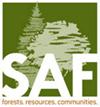Genetic Variability for Clonal Propagation of Acacia mearnsii
IF 1.5
4区 农林科学
Q2 FORESTRY
引用次数: 0
Abstract
Plantations of Acacia mearnsii established from seeds often exhibit low levels of productivity due to significant differences in plant growth. Therefore, the aim of this study was to assess the genetic control associated with clonal propagation of A. mearnsii and use a selection index to quantify gains for traits related to vegetative propagation. Data collected from nurseries for 2 years included mini-cutting productivity per mini-stump (PD), percentage of adventitious rooting (ENR), and ramet productivity index (PI). For clone production traits, PD (r = 0.36) and PI (r = 0.24) demonstrated moderate repeatability, whereas ENR (r = 0.06) exhibited low repeatability. Tree height (H2 = 0.20), and diameter at breast height (H2 = 0.13) showed moderate and low heritability, respectively. Genotype selection for vegetative propagation supported by PI-generated selection gains of over 50%, suggesting the efficacy of using this criterion in early evaluation and selection of genotypes for nursery propagation. The additive selection index considering PI and Ht traits can be used for early selection of superior A. mearnsii genotypes, promoting estimated gains of up to 2.5%. Given the importance of these parameters, these findings provide crucial insights for A. mearnsii breeders, addressing a notable gap in the literature concerning these traits. Study Implications: The moderate heritability of traits such as mini-cutting productivity, propagule productivity index (PI), height, and diameter at breast height, except for the percentage of adventitious rooting, which showed low heritability, suggests that these traits are influenced by genetic factors to a considerable extent. The study suggests that the selection of genotypes based on PI can significantly improve vegetative propagation outcomes, with potential selection gains of more than 50%. This indicates that nurseries can achieve higher productivity and efficiency by implementing genotype selection processes based on this criterion.相思树克隆繁殖的遗传变异性
由于植物生长的显著差异,由种子建立的相思树种植园往往表现出较低的生产力水平。因此,本研究旨在评估与相思树克隆繁殖相关的遗传控制,并使用选择指数来量化无性繁殖相关性状的收益。从苗圃中收集的两年数据包括每个迷你树桩的迷你切割生产力(PD)、不定根百分比(ENR)和莲座生产力指数(PI)。在克隆生产性状方面,PD(r = 0.36)和 PI(r = 0.24)表现出中等重复性,而 ENR(r = 0.06)表现出低重复性。树高(H2 = 0.20)和胸径(H2 = 0.13)分别表现出中等和较低的遗传率。由 PI 支持的无性繁殖基因型选择产生的选择增益超过 50%,表明在苗圃繁殖基因型的早期评估和选择中使用该标准是有效的。考虑到 PI 和 Ht 性状的加性选择指数可用于早期选择优良的 A. mearnsii 基因型,估计可提高 2.5%。鉴于这些参数的重要性,这些发现为 A. mearnsii 的育种者提供了重要的见解,解决了有关这些性状的文献中的一个显著空白。研究意义:除不定根百分比的遗传率较低外,迷你切割生产力、繁殖生产力指数(PI)、高度和胸径等性状的遗传率适中,这表明这些性状在相当程度上受遗传因素的影响。研究表明,根据 PI 选择基因型可显著改善无性繁殖结果,潜在的选择收益超过 50%。这表明,苗圃可以通过实施基于该标准的基因型选择过程来提高生产率和效率。
本文章由计算机程序翻译,如有差异,请以英文原文为准。
求助全文
约1分钟内获得全文
求助全文
来源期刊

Forest Science
农林科学-林学
CiteScore
2.80
自引率
7.10%
发文量
45
审稿时长
3 months
期刊介绍:
Forest Science is a peer-reviewed journal publishing fundamental and applied research that explores all aspects of natural and social sciences as they apply to the function and management of the forested ecosystems of the world. Topics include silviculture, forest management, biometrics, economics, entomology & pathology, fire & fuels management, forest ecology, genetics & tree improvement, geospatial technologies, harvesting & utilization, landscape ecology, operations research, forest policy, physiology, recreation, social sciences, soils & hydrology, and wildlife management.
Forest Science is published bimonthly in February, April, June, August, October, and December.
 求助内容:
求助内容: 应助结果提醒方式:
应助结果提醒方式:


